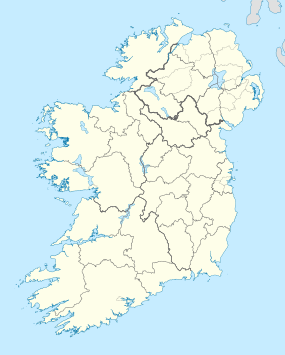Knockaulin

A view of the ditch
|
|
| Alternate name | Dun Aulin |
|---|---|
| Location | County Kildare, Ireland |
| Coordinates | 53°06′54″N 6°46′30″W / 53.115°N 6.775°W |
| Type | Ancient ceremonial site |
| Area | 13 hectares (32 acres) |
| Height | 183 metres (600 ft) |
| History | |
| Material | Earth, timber |
| Periods | Iron Age–Middle Ages |
| Cultures | Gaelic |
Dún Ailinne (pronounced [ˈd̪ˠuːn̪ˠ ˈalʲɪ nʲə]; sometimes anglicized Dun Aulin) is an ancient ceremonial site on the hill of Cnoc Ailinne (Knockaulin) in County Kildare, Ireland. It is southwest of Kilcullen, near the N78 road to Athy. It is a large circular enclosure covering most of the hilltop; about 13 hectares. Archeological investigations show that there were once circular timber structures (or rings of upright timbers) inside the enclosure.
According to Irish mythology, Dún Ailinne was one of the great royal sites of early Gaelic Ireland and is believed to have been where the Kings of Leinster were inaugurated. It is similar to the other royal sites of Tara (Kings of Meath), Navan Fort (Kings of Ulster) and Rathcroghan (Kings of Connacht).
The hill is 183 metres (600 ft) above sea level. It should not be confused with the Hill of Allen (Cnoc Alúine), which is to the northwest.
The site is circular, about 13 ha (32 ac) in area, ringed by an earth bank and ditch (or "henge"). As with most henges, the ditch is on the inside, meaning that it was likely to have been symbolic rather than defensive. It is believed that Dún Ailinne was a royal centre and inaugural or ceremonial site for the Kings of Leinster. In terms of its ritual use, the internal structures and layout, and its location and association, is similar to the other royal sites of Tara, Navan Fort and Rathcroghan (Johnston 2006). Indications of earliest use are from the Neolithic period, but the main activity there was during the Iron Age. It does not seem to have been dwelt in year-round, but was instead mostly used for short-term activity, including ritual. It seems to have been occupied during the Spring/Summer months and there is evidence of cooking, which include a great deal of bone from cows, sheep, pigs, deer and horses (Crabtree 2007, in Johnston and Wailes 2007). A La Tène style sword and Roman bronze fibulae have also been found at the site (Johnston and Wailes 2007). While it figures in some early historical references, Dún Ailinne was mostly abandoned about the time the nearby early Christian settlement at Old Kilcullen was established in the 6th century.
...
Wikipedia

